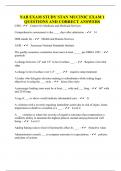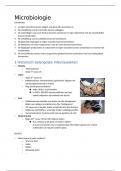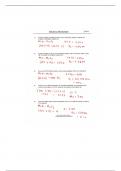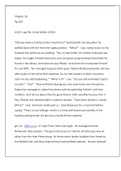1 Transport economics: Introduction
1 Course structure
CONTEXT
• 3 credits → 24-30 course hours
• Written exam, closed book
• Pre-requisites:
o Basic knowledge of economics, business economics and research methodology
• Final competences
o Analyst: You have analytical insight in logistics and transport.
o Analyst: You master generic principles and research methods .
o Analyst: You have ready knowledge of logistics and transport, at management level.
o Communicator: You can formulate an answer to an open exam question concerning
transport economics in a clear and structured way.
• Lecture material:
o Asynchronous videos with theory
o Synchronous (online or on-campus) application and Q&A
o Slides (via blackboard)
o Book: G. Blauwens, P. De Baere, E. Van de Voorde, Transport Economics, 7th edition,
De Boeck, 2020, ISBN 978 90 306 9662 9 Part I.1 The traffic and Transport system;
Part III – Transport Supply and Demand; Part IV – Transport Policy
COURSE STRUCTURE
• 1. On-line, asynchronous lecture, theory
o To be watched before the synchronous case lecture
• 2. On-campus synchronous application and Q&A – attendance required
• 3. Rinse and repeat
• 4. Guest speakers
2 Our department
INTERNATIONAL CO-OPERATION
• TransportNET (co-operation agreement between 7 European transport universities)
o Karlsruhe Institute of Technology
o University of Lyon
o University of Lisbon
o Delft University of Technology
o University of Antwerp
o University of Genova
o University of the Aegean
• Education and research
,RESEARCH THEMES
• The interaction between transport and economics
• Freight transport
• The port and maritime sector
• The air transport business and markets
• Urban logistics and distribution
• The assessment of infrastructure projects
• Strategic analyses and policy recommendations (private companies, authorities)
• Interaction between transport and physical planning
• Urban studies and regional economics
3 Varia
FLOWS
• Online magazine (in Dutch) on the transport and maritime world
• Background information for courses, bachelor/master, thesis,…
• Practical information on how to register: see blackboard
INTERESTED IN TRASNPORT AND LOGISTICS?
• Master maritiem en logistiek management (in Dutch)
o In-depth knowledge about transport and logistics world
o Economic, legal and technological perspective
o Strong link with practice (excursions, guest lectures)
o Start of your own network in the sector
o Own Dutch-speaking master on this topic in Flanders
• Interested?
o www.uantwerpen.be/master-maritiem-en-logistiek-management
4 Contact data
,5 Derived demand
DERIVED DEMAND GRAPH
• !!! Transport is a derived demand
o Nobody transport goods just for the fun of transporting
o Nobody travels for the fun of driving from A to B
▪ The going itself is not the object of the travel
o Derived demand= there must be a reason to transport goods from A to B
▪ Therefor just building infrastructure is a bad idea → if nobody wants to go
there
• Graph:
o Standard supply and demand picture
▪ Dg: demand for goods → going downwards → the lower the price, the
higher the quantity
▪ Sa: supplier will supply more if the prices are higher → going up
o Crosspoint A: balance between supply and demand
▪ BUT what is often forgotten, is that there are actually customers at point
K&C who are willing to pay more, but that doesn’t mean that they will pay
more. If someone is selling at price A, why would you pay price K or C.
o Consumer surplus:
▪ Triangle above line A
▪ People who actually want to pay more than A, but don’t need to pay more
than A, so they make a profit
▪ Same can happen on the supply side
▪ WTP= willingness to pay
o Producer surplus
▪ Some suppliers would have been willing to sell at price L or B
▪ These people are making profit because they are selling at price A, but there
actual price was B or L so they get more money then they wanted
o Producer + consumer surplus
▪ Allows for transport
▪ Imagine a supplier L and a customer K. L is willing to sell at a lower price than
the market price and K is willing to pay a higher price than the market price.
▪ So there is a difference between the price that L wants and the price that K is
willing to pay (K-L=M)
▪ K-L=M (vertical line going from K to L) → = the amount of money that they
are willing to pay for transport (amount available for transport)
• And C-B=T
o ° Second pair of demand and supply curves
▪ St: supply of transport (increases)
▪ Dt: demand for transport (drops)
▪ Equilibrium M= people are willing to pay an M amount for transport which
covers the distance from K to L.
• If there would be no price difference from K and L, there would be
no demand for transport
, • Why do people transport goods from A to B ?
o Because they can get a better price in B than in A (this is what the graph shows)
o At a destination point, they get a better price at the origin point and this price
difference can be used to pay for transport
o M.a.w worthless at the point of collection but valuable at the point of consumption
DERIVED DEMAND (steps explained)
• Traffic and transportation hardly ever arise spontaneously
• Traffic and transportation are the result of some other primary need for goods and services
• Traffic and transportation thus shows an intermediary character and it is a derived need
(derived nature)
• Graphical analysis: the derived nature of transport demand
o Starting situation: a commodity is supplied in Antwerp and demanded for in Ghent,
and the commodity thus needs to be transported
o Step 1: consider a quantity x (less than Y)
o Step 2: determine the delivery price OB
o Step 3: determine the willingness to pay OC
o Step 4: OC – OB gives the basics of calculating the MAXIMUM cost of transportation
o Step 5: derive Dt
o Step 6: assume St (upward sloping curve and based on marginal costs)
o Step 7: determine E (new quantity equilibrium taking into account transportation
costs)
1 Course structure
CONTEXT
• 3 credits → 24-30 course hours
• Written exam, closed book
• Pre-requisites:
o Basic knowledge of economics, business economics and research methodology
• Final competences
o Analyst: You have analytical insight in logistics and transport.
o Analyst: You master generic principles and research methods .
o Analyst: You have ready knowledge of logistics and transport, at management level.
o Communicator: You can formulate an answer to an open exam question concerning
transport economics in a clear and structured way.
• Lecture material:
o Asynchronous videos with theory
o Synchronous (online or on-campus) application and Q&A
o Slides (via blackboard)
o Book: G. Blauwens, P. De Baere, E. Van de Voorde, Transport Economics, 7th edition,
De Boeck, 2020, ISBN 978 90 306 9662 9 Part I.1 The traffic and Transport system;
Part III – Transport Supply and Demand; Part IV – Transport Policy
COURSE STRUCTURE
• 1. On-line, asynchronous lecture, theory
o To be watched before the synchronous case lecture
• 2. On-campus synchronous application and Q&A – attendance required
• 3. Rinse and repeat
• 4. Guest speakers
2 Our department
INTERNATIONAL CO-OPERATION
• TransportNET (co-operation agreement between 7 European transport universities)
o Karlsruhe Institute of Technology
o University of Lyon
o University of Lisbon
o Delft University of Technology
o University of Antwerp
o University of Genova
o University of the Aegean
• Education and research
,RESEARCH THEMES
• The interaction between transport and economics
• Freight transport
• The port and maritime sector
• The air transport business and markets
• Urban logistics and distribution
• The assessment of infrastructure projects
• Strategic analyses and policy recommendations (private companies, authorities)
• Interaction between transport and physical planning
• Urban studies and regional economics
3 Varia
FLOWS
• Online magazine (in Dutch) on the transport and maritime world
• Background information for courses, bachelor/master, thesis,…
• Practical information on how to register: see blackboard
INTERESTED IN TRASNPORT AND LOGISTICS?
• Master maritiem en logistiek management (in Dutch)
o In-depth knowledge about transport and logistics world
o Economic, legal and technological perspective
o Strong link with practice (excursions, guest lectures)
o Start of your own network in the sector
o Own Dutch-speaking master on this topic in Flanders
• Interested?
o www.uantwerpen.be/master-maritiem-en-logistiek-management
4 Contact data
,5 Derived demand
DERIVED DEMAND GRAPH
• !!! Transport is a derived demand
o Nobody transport goods just for the fun of transporting
o Nobody travels for the fun of driving from A to B
▪ The going itself is not the object of the travel
o Derived demand= there must be a reason to transport goods from A to B
▪ Therefor just building infrastructure is a bad idea → if nobody wants to go
there
• Graph:
o Standard supply and demand picture
▪ Dg: demand for goods → going downwards → the lower the price, the
higher the quantity
▪ Sa: supplier will supply more if the prices are higher → going up
o Crosspoint A: balance between supply and demand
▪ BUT what is often forgotten, is that there are actually customers at point
K&C who are willing to pay more, but that doesn’t mean that they will pay
more. If someone is selling at price A, why would you pay price K or C.
o Consumer surplus:
▪ Triangle above line A
▪ People who actually want to pay more than A, but don’t need to pay more
than A, so they make a profit
▪ Same can happen on the supply side
▪ WTP= willingness to pay
o Producer surplus
▪ Some suppliers would have been willing to sell at price L or B
▪ These people are making profit because they are selling at price A, but there
actual price was B or L so they get more money then they wanted
o Producer + consumer surplus
▪ Allows for transport
▪ Imagine a supplier L and a customer K. L is willing to sell at a lower price than
the market price and K is willing to pay a higher price than the market price.
▪ So there is a difference between the price that L wants and the price that K is
willing to pay (K-L=M)
▪ K-L=M (vertical line going from K to L) → = the amount of money that they
are willing to pay for transport (amount available for transport)
• And C-B=T
o ° Second pair of demand and supply curves
▪ St: supply of transport (increases)
▪ Dt: demand for transport (drops)
▪ Equilibrium M= people are willing to pay an M amount for transport which
covers the distance from K to L.
• If there would be no price difference from K and L, there would be
no demand for transport
, • Why do people transport goods from A to B ?
o Because they can get a better price in B than in A (this is what the graph shows)
o At a destination point, they get a better price at the origin point and this price
difference can be used to pay for transport
o M.a.w worthless at the point of collection but valuable at the point of consumption
DERIVED DEMAND (steps explained)
• Traffic and transportation hardly ever arise spontaneously
• Traffic and transportation are the result of some other primary need for goods and services
• Traffic and transportation thus shows an intermediary character and it is a derived need
(derived nature)
• Graphical analysis: the derived nature of transport demand
o Starting situation: a commodity is supplied in Antwerp and demanded for in Ghent,
and the commodity thus needs to be transported
o Step 1: consider a quantity x (less than Y)
o Step 2: determine the delivery price OB
o Step 3: determine the willingness to pay OC
o Step 4: OC – OB gives the basics of calculating the MAXIMUM cost of transportation
o Step 5: derive Dt
o Step 6: assume St (upward sloping curve and based on marginal costs)
o Step 7: determine E (new quantity equilibrium taking into account transportation
costs)










